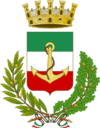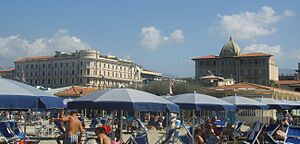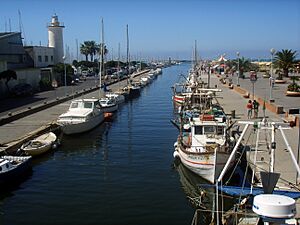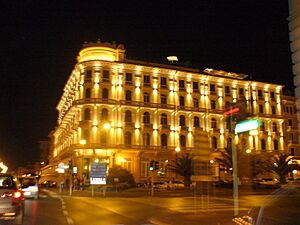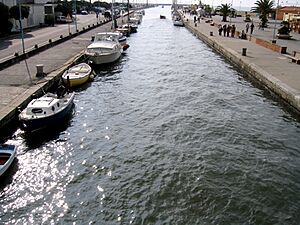Viareggio facts for kids
Quick facts for kids
Viareggio
|
||
|---|---|---|
| Città di Viareggio | ||
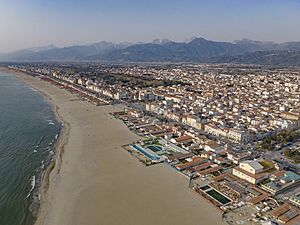
Aerial view of Viareggio (2022)
|
||
|
||
| Country | Italy | |
| Region | Tuscany | |
| Province | Lucca | |
| Frazioni | Torre del Lago Puccini | |
| Area | ||
| • Total | 32.42 km2 (12.52 sq mi) | |
| Elevation | 2 m (7 ft) | |
| Population
(31 March 2017)
|
||
| • Total | 62,169 | |
| • Density | 1,917.61/km2 (4,966.6/sq mi) | |
| Demonym(s) | Viareggini, Torrelaghesi | |
| Time zone | UTC+1 (CET) | |
| • Summer (DST) | UTC+2 (CEST) | |
| Postal code |
55049, 55048
|
|
| Dialing code | 0584 | |
| Patron saint | Maria Santissima Annunziata | |
| Saint day | March 25 | |
Viareggio is a lively city in northern Italy. It is located in the beautiful region of Tuscany, right on the coast of the Tyrrhenian Sea. With over 62,000 people living there, it's the second-biggest city in the province of Lucca, after Lucca itself.
Viareggio is famous for its lovely beaches and as a popular seaside resort. It's also home to the amazing Carnival of Viareggio, which started way back in 1873. During the carnival, huge floats made of papier-mâché parade along the "Passeggiata a mare" (seaside promenade). This tradition began in 1925. The carnival's official mascot is Burlamacco, a fun character created in 1930 by Uberto Bonetti.
The city's story began in the early 1500s. It became the only sea port for the Republic of Lucca. The oldest building in Viareggio, called Torre Matilde, was built in 1541. It was a fort to protect the city from pirate attacks.
Viareggio is also a busy place for industry and making things. Its shipbuilding industry is known worldwide for building amazing boats. Fishing and growing flowers are also important parts of the city's economy.
Viareggio hosts the Premio letterario Viareggio Répaci, a famous literature award started in 1929. Another cool event is the Festival Gaber, held every August since 2004. It celebrates the musician Giorgio Gaber and features many well-known Italian artists.
Contents
Discovering Viareggio's Past
The City's Symbol: Coat of Arms
Viareggio's current coat of arms was chosen in 1848. It replaced an older one from 1752 that showed Saint Anthony from Padua.
The new coat of arms features an anchor with a rope on a shield with white, red, and green colors. Viareggio was one of the first towns to use these colors, which later became the official flag of Italy, even before Italy was united!
Early Days: Ancient and Medieval Times
Around 300 BC, Ligurian tribes moved into the mountains of Versilia, reaching as far south as the Arno river. In 180 BC, the Romans defeated them and started settling in the area.
Most people believe Viareggio's name comes from the Latin words Via Regis, meaning "Kings' Road." This was a medieval road connecting a fort on the beach to Lucca. Other historians think it comes from Vicus Regius, meaning "Royal Village," because there was a small settlement here that belonged to the empire.
During the Middle Ages, many hillside towns grew, and some are still active today. The area where Viareggio now stands was mostly marshland and not lived in. Around 1000 AD, Lucca and Pisa began fighting over control of the Versilia coast. Lucca wanted access to the sea, and Pisa worried about competition.
The first time Viareggio was mentioned was in 1169, when a wooden tower was built to guard the coast. In 1172, a military building called Turris de Via Regia was built, named after the road to Lucca. The area saw many small battles and invasions. It was also affected by a widespread sickness, as told by Giovanni Boccaccio in his book Decameron.
From the 15th to 17th Centuries
During these centuries, Florence expanded its control over Tuscany. However, Lucca managed to stay independent by paying a lot of money.
In 1513, Pope Leo X took the port of Motrone away from Lucca. This made Viareggio very important for Lucca, which then focused on making it its main trading center. A square-shaped tower was built in 1534 to protect the port, and more settlements started to appear.
The 1600s were tough for Viareggio's 300 residents. The area was unhealthy, and diseases like malaria made life hard for fishermen and farmers. Lucca worked hard to drain the marshlands to improve living conditions and encouraged people to move to the new town.
Slowly, Viareggio changed. Two small churches and factories were built, followed by shops. The port became busier, and people started farming the drained land.
The 18th and 19th Centuries
In 1701, Viareggio became a comune (a local government area). By 1739, thanks to engineer Bernardino Zendrini, the marshlands were fully drained. Viareggio then became a place where rich families from Lucca built their grand homes.
In May 1799, the people of Viareggio protested against the Jacobin Club.
When Napoleon invaded Italy, the Lucchese state became a principality. Felice Baciocchi was given power, but Napoleon's sister, Elisa, held the real control. Elisa's rule had some unpopular decisions, but also some good ones. She brought in the "Napoleonic Code" (a set of laws), the metric system, and required vaccinations against smallpox.
After Napoleon's fall, Viareggio saw some violence. In March 1814, people protested against the French, which led to acts of vandalism.
Viareggio was controlled by the Austrians until 1817. Then, as part of the Congress of Vienna agreements, Maria Luisa of Spain became the ruler of the new Duchy of Lucca. She helped the town grow by building its first marina (seaside area). In 1820, Viareggio officially became a city.
After Maria Luisa's death in 1824, Charles Louis of Parma took over. He greatly helped Viareggio expand by building a new church, a royal casino, and the city's first two beach resorts.
On October 5, 1847, Lucca became part of the Grand Duchy of Tuscany. Viareggio then grew as a seaside resort for all of Tuscany. In 1848, the city adopted its current coat of arms. Many thinkers who were exiled during the Italian Risorgimento (the movement to unite Italy) found a safe place in Viareggio.
During these years, Viareggio's economy grew fast. Beach tourism was popular, and the sailboat industry expanded. The population increased from 300 in 1740 to 6,549 in 1841.
The 20th Century and Beyond
The early 1900s brought more growth for the coast and tourism. The Passeggiata (promenade) was created with cafes and shops. This helped Viareggio become known as the "Pearl of the Tyrrhenian Sea." Many buildings were made of wood, and in 1917, a big fire destroyed a large part of the city overnight. Later, during the fascist era, other materials replaced wood in construction.
During World War II, Viareggio was heavily bombed, and entire parts of the city were destroyed.
After the war, reconstruction began, and the city's look changed a lot. Today, Viareggio is still a famous seaside resort, known for its carnival and shipbuilding.
In 2009, a train carrying gas had an accident near Viareggio's railway station. This caused an explosion that sadly affected many people and homes near the station.
Viareggio's Location and Landscape
Viareggio is located on the flat coastal area of Versilia. It faces the Ligurian Sea (though it's often thought of as facing the Tyrrhenian Sea). It has about 10 kilometers (6 miles) of sandy beaches. About 6 kilometers (3.7 miles) are managed by private beach resorts, and the other 4 kilometers (2.5 miles) are public. Much of the public beach is part of the Parco Naturale Regionale Migliarino-San Rossore-Massaciuccoli. Viareggio is next to the towns of Camaiore, Massarosa, and Vecchiano (PI).
The city's area includes the Lake of Massaciuccoli and several canals. The most important canals are Burlamacca, Farabola, Fossa dell'Abate (which borders Camaiore), and Fosso Le Quindici.
City Areas
Viareggio has one main subdivision called frazione, which is Torre del Lago Puccini. About 11,000 people live there.
The city itself is divided into four main areas:
- Circoscrizione no. 1: Torre del Lago Puccini.
- Circoscrizione no. 2: Centro Marco Polo.
- Circoscrizione no. 3: Darsena/ex Campo d'Aviazione.
- Circoscrizione no. 4: Viareggio Nuova.
Weather in Viareggio
The climate here has high humidity, usually between 60% and 80% in summer. It rains about 700 to 1000 millimeters (27 to 39 inches) each year. This is because the Apuanian Alps are close to the coast.
The main winds blow from the southeast: the Libeccio and the Ponente. These winds can cause strong storms for a few days.
In winter (December-February), high temperatures are usually around 14-15°C (57-59°F), and lows are around 4-5°C (39-41°F). Night temperatures can drop below 0°C (32°F) about 24 times a year. In summer (June-August), temperatures reach about 31-33°C (88-91°F), with the hottest day of the year around 35°C (95°F).
| Climate data for Pisa ITA, 1991–2020, Extremes 1973- | |||||||||||||
|---|---|---|---|---|---|---|---|---|---|---|---|---|---|
| Month | Jan | Feb | Mar | Apr | May | Jun | Jul | Aug | Sep | Oct | Nov | Dec | Year |
| Record high °C (°F) | 18.0 (64.4) |
21.0 (69.8) |
24.5 (76.1) |
28.0 (82.4) |
34.4 (93.9) |
37.6 (99.7) |
39.0 (102.2) |
38.5 (101.3) |
36.0 (96.8) |
30.2 (86.4) |
24.0 (75.2) |
20.4 (68.7) |
39.0 (102.2) |
| Mean daily maximum °C (°F) | 11.5 (52.7) |
12.6 (54.7) |
15.6 (60.1) |
18.6 (65.5) |
22.7 (72.9) |
27.1 (80.8) |
29.9 (85.8) |
30.4 (86.7) |
26.1 (79.0) |
21.4 (70.5) |
16.1 (61.0) |
12.2 (54.0) |
20.4 (68.7) |
| Daily mean °C (°F) | 7.7 (45.9) |
7.7 (45.9) |
10.5 (50.9) |
13.3 (55.9) |
17.1 (62.8) |
21.3 (70.3) |
24.0 (75.2) |
24.4 (75.9) |
20.5 (68.9) |
16.6 (61.9) |
12.0 (53.6) |
8.0 (46.4) |
15.3 (59.5) |
| Mean daily minimum °C (°F) | 2.6 (36.7) |
2.8 (37.0) |
5.4 (41.7) |
8.0 (46.4) |
11.6 (52.9) |
15.5 (59.9) |
18.1 (64.6) |
18.5 (65.3) |
14.9 (58.8) |
11.8 (53.2) |
7.8 (46.0) |
3.8 (38.8) |
10.2 (50.4) |
| Record low °C (°F) | −17.0 (1.4) |
−8.0 (17.6) |
−8.0 (17.6) |
−3.0 (26.6) |
2.0 (35.6) |
4.0 (39.2) |
9.0 (48.2) |
8.0 (46.4) |
5.0 (41.0) |
0.8 (33.4) |
−9.6 (14.7) |
−10.4 (13.3) |
−17.0 (1.4) |
| Average rainfall mm (inches) | 58.30 (2.30) |
57.01 (2.24) |
61.63 (2.43) |
48.71 (1.92) |
55.64 (2.19) |
34.36 (1.35) |
26.82 (1.06) |
34.39 (1.35) |
83.16 (3.27) |
104.81 (4.13) |
114.54 (4.51) |
76.95 (3.03) |
756.34 (29.78) |
| Average relative humidity (%) | 77.4 | 73.6 | 72.5 | 73.9 | 74.0 | 71.7 | 69.2 | 70.5 | 73.3 | 77.6 | 79.3 | 78.8 | 74.3 |
| Source 1: Il Meteo Humidity. | |||||||||||||
| Source 2: MeteoStat All temperatures and rainfall. | |||||||||||||
Viareggio's Economy
Viareggio's main economic activities are tourism, shopping, and services. Fishing and floriculture (growing flowers) are also very important.
The city is also home to many successful shipyards.
In the early 1800s, Viareggio's craftspeople built small fishing boats along the Burlamacca canal. This small boat-building business grew and became famous worldwide. Today, Viareggio is a top city for building luxury yachts. Many well-known shipbuilders like Azimut Benetti, Codecasa, Fipa, Rossinavi, and Perini navi are located here.
Culture and Fun in Viareggio
The Famous Carnival
The Carnival of Viareggio started in 1873. The amazing papier mâché floats, which are a huge part of the parades, were first used in 1925. The carnival's official mascots are Burlamacco and Ondina, first drawn in 1930.
Since 1954, the Italian TV channel RAI has broadcast the entire event. Since 2001, the carnival artists have worked in the Cittadella del Carnevale, which means "Carnival Town."
Awards and Recognition
- Premio letterario Viareggio Repaci: A literature award started in 1929.
- Premio internazionale Artiglio.
- Premio Sport Città di Viareggio.
- Premio Viareggio Sport.
Exciting Events
- The Festival Puccini: Held every summer in Torre del Lago Puccini between July and August. It's an open-air theater with 3,200 seats right by lake Massaciuccoli. A new permanent theater opened in 2009.
- Jazz and more...: A music festival held since 2002.
- Festival teatro canzone – Giorgio Gaber: Held since 2004.
- Viareggio Incontri: Takes place at "Il Principino" on the Promenade.
- EuropaCinema: An international film festival focusing on European movies. It started in 1984 and moved to Viareggio in 1989.
- The Torneo Mondiale Giovanile di Calcio "Coppa Carnevale": One of the most important youth football (soccer) tournaments in the world, with teams from many countries.
Places to See in Viareggio
- Villa Orlando
- Villa Borbone (between Viareggio and Torre del Lago Puccini).
- Villa Puccini, which is now a museum.
- Monument to the Resistance and to Peace, located in Largo Risorgimento. This monument uses columns from the old City Hall, which was destroyed in World War II bombings. It features a mosaic by Jean-Michel Folon and a quote from Quasimodo: "And how could we sing with foreign feet trampling onto our hearts?"
Sports in Viareggio
The city is home to the roller hockey team CGC Viareggio. In 2011, they became the first club from Lucca province to win the Serie A1 Italian hockey title.
Viareggio also has its own association football (soccer) team, F.C. Esperia Viareggio.
There's also a professional beach soccer team called Viareggio Beach Soccer.
Getting Around Viareggio
Motorways
Viareggio is connected to the A11 motorway from Florence and the A12 motorway, which links Genoa and Rosignano.
Train Travel
Viareggio railway station is close to the city center. About 60 trains run daily on the Rome–Pisa–La Spezia–Genoa line and the line to Florence. There are also international trains.
Airports Nearby
The closest airport is Pisa's "Galileo Galilei" international airport, which is only about 20 kilometers (12 miles) south of Viareggio. Florence's "Amerigo Vespucci" airport is about 95 kilometers (59 miles) to the east.
Port and Marinas
Two extensions to the Burlamacca canal were built in 1577, and this is where the first sea activities began. In 1740, Bernardino Zendrini built a water-gate to stop seawater from reaching Lake Massaciuccoli. In 1820, Maria Luisa, the Duchess of Lucca, had Viareggio's first marina built. It was finished in 1823 and called the Marina of Lucca. Later, the Marina of Tuscany was built (1871-1873), followed by the Marina of Italy (1907-1911).
In 1938, the Marina of the Empire was built. In the 1970s, the Marina of Viareggio (also known as the New Marina), the Marina of La Madonnina, and a new lighthouse were added. The Madonnina marina can hold up to 500 boats. The city is home to the local Coast Guard, and all boats registered here have the marking VG.
Images for kids
Viareggio's Global Connections
Viareggio has sister cities around the world:
 Bastia, France
Bastia, France Shëngjin, Albania
Shëngjin, Albania Bridgeport, US
Bridgeport, US Kunshan, China
Kunshan, China Opole, Poland
Opole, Poland Palmi, Italy
Palmi, Italy San Benedetto del Tronto, Italy
San Benedetto del Tronto, Italy Pasto, Colombia
Pasto, Colombia
Famous People from Viareggio
- Princess Maria Antónia of Bragança was born here.
- Pierluigi Collina, a famous football referee.
- Marcello Lippi, a well-known football manager.
- Mario Monicelli, a famous film director.
- Stefania Sandrelli, a talented actress.
- Percy Bysshe Shelley (1792–1822), an English poet whose body was cremated here.
- Mario Tobino (1910–1991), a doctor, poet, and writer.
See also
 In Spanish: Viareggio para niños
In Spanish: Viareggio para niños


